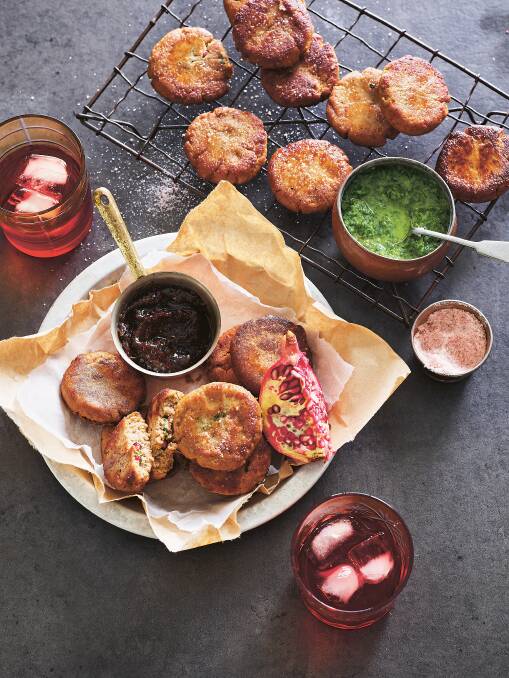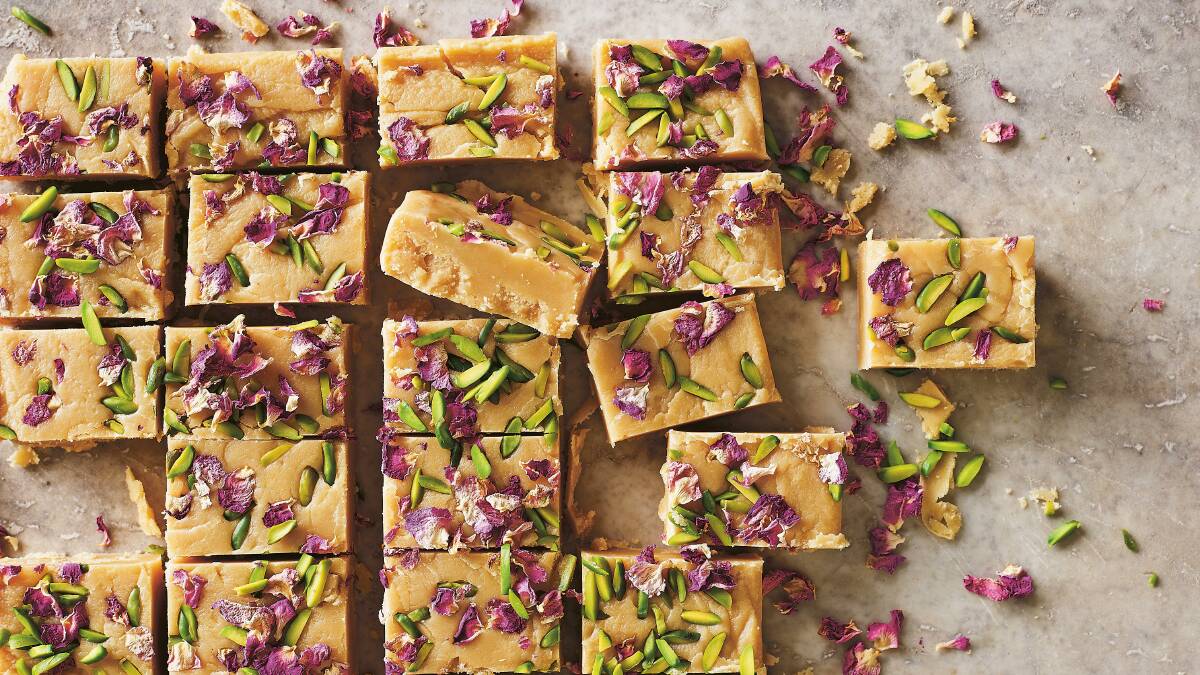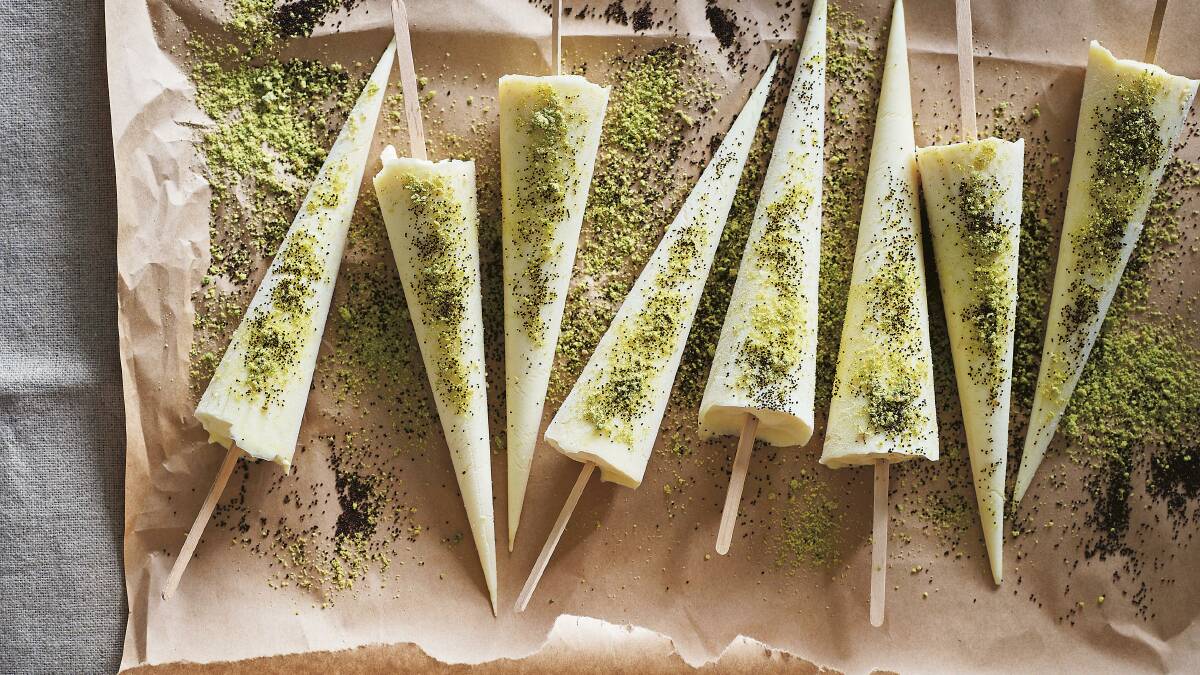Award-winning food writer Sumayya Usmani’s stunning memoir conjures a story of what it was like growing up in Pakistan and how the women in her life inspired her to trust her instincts in the kitchen.
This evocative and moving food memoir – which includes the most meaningful recipes of Usmani’s childhood – tells the story of how her self-belief grew throughout her young life, allowing her to trust her instincts and find her own path between the expectations of following in her father’s footsteps as a lawyer and the pressures of a Pakistani woman’s presumed place in the household. Gradually, through the warmth of her family life, the meaning of “andaza” comes to her: that the flavour and meaning of a recipe is not a list of measured ingredients, but a feeling in your hands, as you let the elements of a meal come together through instinct and experience. Andaza: A memoir of food, flavour and freedom in the Pakistani kitchen.
Chicken Boti tikka, Bundoo Khan Style
Family weekend trips to our favourite open-air barbecue restaurant meant we’d get to eat boti tikka with flatbreads and tamarind chutney – as the grown-up chat bored me, that was the only reason I’d willingly go along. For this recipe, you’ll need some bamboo skewers to thread the cubes of chicken on; remember to soak them for at least half an hour so they don’t get singed in the oven. Serve with naan or basmati rice.
Ingredients
- 1/2 tsp chilli powder
- 1/2 tsp crushed black peppercorns
- 1/4 tsp turmeric powder
- 1 tsp cumin seeds, roasted in a dry frying pan and ground
- 1 tsp coriander seeds, roasted in a dry frying pan and ground
- 1/2 tsp garam masala
- 1/2 tsp unsmoked paprika
- 3 garlic cloves, crushed
- 2.5 cm ginger, finely grated salt, to taste
- juice of 1 lemon
- 4 skinless chicken breast fillets, cut into 2cm cubes
- 2-3 tbsp sunflower oil
For the tamarind chutney:
- 100g dried tamarind – about half a block
- 4-5 tbsp dark brown sugar
- 1 tsp salt
- 1 tsp cumin seeds, roasted in a dry frying pan
- 1/2 tsp crushed black peppercorns
- 1/2 tsp chilli powder
Method
1. In a large bowl, mix the spices, garlic, ginger and salt with the lemon juice. Add the chicken and leave in the fridge to marinate for at least one hour, or as long as overnight.
2. In the meantime, soak about six bamboo skewers in water and make the chutney. Put the tamarind into a small saucepan with 150ml of water, the sugar, salt and spices. Bring to the boil and stir until the block of tamarind breaks up and the sugar and salt have dissolved, about 10-15 minutes. Strain through a fine-mesh sieve into a bowl, discarding the tamarind seeds and cumin seeds. Set the chutney aside while you cook the chicken.
3. Preheat the oven to 180C and line a baking tray with baking paper. Thread about four chicken pieces onto each bamboo skewer, then place on the baking tray. Brush the chicken with oil and cook for 20-25 minutes in the oven, or until the chicken is brown around the edges and cooked through.
4. Serve hot, with the bowl of chutney alongside.
Serves 4-6.
Family Shami Kebabs

Family shami kebabs. Picture by Alicia Taylor
Both of my grandmothers and my mother cooked these, and this is a combination of all their recipes. Feel free to double the amounts: cooked shami kebabs freeze well and my mothers freezer is never without a batch. They can be served as a starter with drinks, or as a treat with afternoon tea, accompanied by chutney, pickle or ketchup – and chai, of course. They are also great with rice, daal and a pickle, alongside a main meal.
Ingredients
- 4cm ginger, roughly chopped
- 1 egg, lightly beaten
- 2 tbsp pomegranate seeds
- 3 tbsp sunflower oil
For the coriander and mint chutney:
- 100g coriander leaves with stems, but not roots
- 2 green chillies, deseeded if desired, roughly chopped – optional
- 15-20 mint leaves
- salt, to taste
- juice of 1/2 lemon
For the kebab mixture:
- 175g chana daal (split chickpeas) or yellow split peas
- 650g lean minced beef
- 1 onion, peeled and cut into quarters
- 4 garlic cloves, peeled but left whole
- 1 cinnamon stick
- 6 green cardamom pods, bruised
- 2 star anise
- 1 dried red chilli
- 1 bay leaf
- 1 tbsp cumin seeds, roasted in a dry frying pan and ground
- 1/2 tbsp coriander seeds, roasted in a dry frying pan and ground
- 10 black peppercorns, coarsely ground
- 1 tomato, cut into quarters
- salt, to taste
Method
1. For the kebab mixture, soak the chana daal in a bowl of water for 30 minutes. Place all the remaining ingredients in a large saucepan with a lid. Pour in about 450ml of water, just enough to cover everything. Cook over medium heat, stirring regularly, for 30-40 minutes, or until the water has evaporated completely – the mixture needs to be very dry.
. Meanwhile, make the chutney by blending all the ingredients in a blender or small food processor.
3. The chutney needs to be thick enough to work as a stuffing for the kebabs, so don’t be tempted to add any water to help with the blending.
4. Once the kebab mixture is bone-dry, remove the cinnamon, cardamom pods, star anise, chilli and bay leaf.
5. Transfer the kebab mixture to a food processor, along with the ginger, and blitz to a smooth paste. Add the egg and blitz again to combine.
6. To make the shami kebabs, mould two tablespoons of the mixture into a ball about the size of a golf ball. Using your thumb, make a hollow in the centre and add about half a teaspoon of the chutney and a couple of pomegranate seeds, then form the mixture back around them, enclosing the stuffing completely. Gently flatten the kebab into a burger shape. Continue until all the mixture is used up.
7. To cook the kebabs, heat the oil in a frying pan over medium heat and fry the kebabs in batches for two to three minutes on each side until well browned. Remove and drain on paper towels.
8. Eat immediately, with any remaining chutney on the side, or freeze for up to three months, remembering to let them thaw before reheating thoroughly.
Makes about 15-20, enough to serve 6-8.
Saffron Black Cardamom Fudge

Saffron black cardamom fudge. Picture by Alicia Taylor
This recipe is based on my mother’s fudge; the flavour of black cardamom becomes intense when heated, so don’t be tempted to add more than a few seeds from the pod – you can use the rest in pullao or to make chai.
Ingredients
- 1 black cardamom pod, cracked open, 3-4 seeds extracted and ground
- 350g sweetened condensed milk, or non-dairy alternative
- 150ml full-cream milk, or non-dairy alternative
- 115g unsalted butter
- 450g demerara sugar
- small pinch of saffron threads
- 1 tbsp edible dried organic rose petals
- 1 tbsp pistachio slivers
Method
1. Line a 20cm square tin with baking paper and set aside.
2. Put the cracked cardamom pod and the ground seeds into a non-stick or heavy-based saucepan with the condensed milk, milk, butter and sugar. Stir over medium heat until the butter has melted and the sugar has dissolved, then bring to a steady boil, stirring constantly.
3. Let the mixture boil for about three minutes, or until the temperature reaches 115C on a sugar thermometer. (As we never had one on the ship, Mummy would drop a little of the bubbling mixture onto a cold plate – if it formed a soft ball and didn’t stick to our fingers, it was ready!)
4. Lightly crush the saffron between your fingertips. Add it to the pan and stir in with a wooden spoon, then take the pan off the heat and carefully fish out the cardamom pod.
5. Let the fudge mixture sit for four to five minutes, then beat with the wooden spoon until it begins to come together into a ball and leaves the sides of the pan. If you like your fudge chewy, stop beating now; if you like it to be more melt-in-the-mouth, keep beating until it starts to get crumbly.
6. Once the fudge has reached your desired consistency, press it into the tin, smoothing it with the back of the spoon. Sprinkle with the rose petals and pistachio slivers, pressing them into the fudge.
7. Leave the fudge to cool and set – this will take about 1-11/2 hours – before scoring it, then cut into pieces and store in a tin or jar for up to two weeks.
Makes about 30-35 pieces.
Street-Side Kulfi, Mummy’s Style

Street-side kulfi, Mummy’s style. Picture by Alicia Taylor
You can find kulfi moulds at some Asian shops and kitchenware suppliers but making the cones with baking paper is a lovely thing to do – it gives the kulfi the tapered shape I remember from the kulfi vendors on the streets of Karachi.
Ingredients
- 5-6 green cardamom pods, cracked open, seeds extracted and ground
- 1 x 397g tin of sweetened condensed milk
- 500ml full-cream milk
- 4 tbsp ricotta
- 5 tbsp dried full-cream milk powder
- 1 tbsp cornflour
- large pinch of saffron threads
- 1 1/2 tbsp pistachios, finely ground using a pestle and mortar – you need 2 tbsp ground pistachios
- 1 tbsp almond meal
- honey or sugar, to taste – optional
- poppy seeds, to decorate
Method
1. Place the cardamom, condensed milk, milk, ricotta, milk powder and cornflour in a blender or food processor and blend until combined. Pour the mixture into a saucepan and heat over low heat, stirring regularly. Keep stirring and cooking until the mixture thickens, about 15-20 minutes.
2. Stir in the saffron, half of the ground pistachios and half of the ground almonds. Let them warm through, then take the pan off the heat.
3. When the mixture has cooled slightly, taste it and adjust the sweetness by adding honey or sugar, if necessary, then leave to cool to room temperature.
4. Pour the cooled mixture into kulfi moulds, then seal and freeze overnight. You could also use cones made from baking paper to make kulfi on a stick: stand each cone upright in a small glass (or a cream horn mould, if you have one) and pour in the mixture to the top of the cone. Let them semi-freeze for an hour or two before inserting a lolly (popsicle) stick into each one.
5. When ready to serve, if using moulds, dip them into warm water to help ease out the kulfi. If using paper cones, gently peel the paper away to reveal your kulfi on a stick. Roll the kulfi through the poppy seeds and the remaining ground pistachios and almonds to decorate, then eat immediately.
Source : Canberra Times















